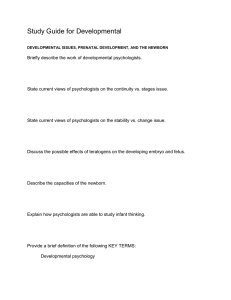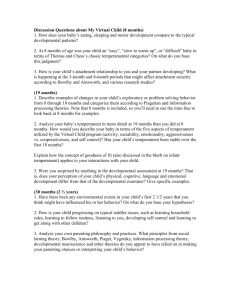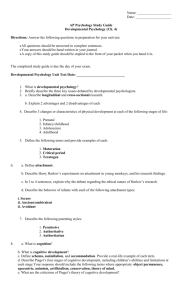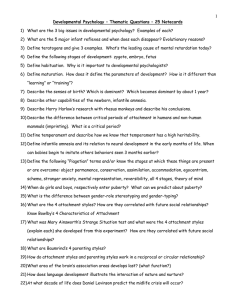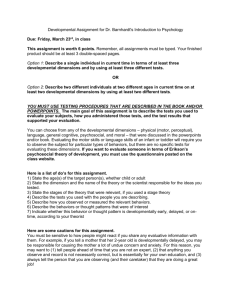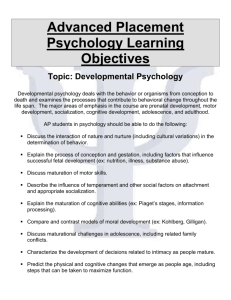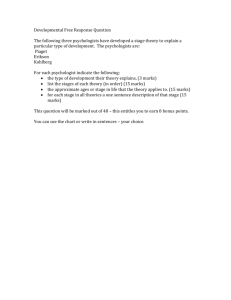Developing Through the Life Span – Chapter 4
advertisement
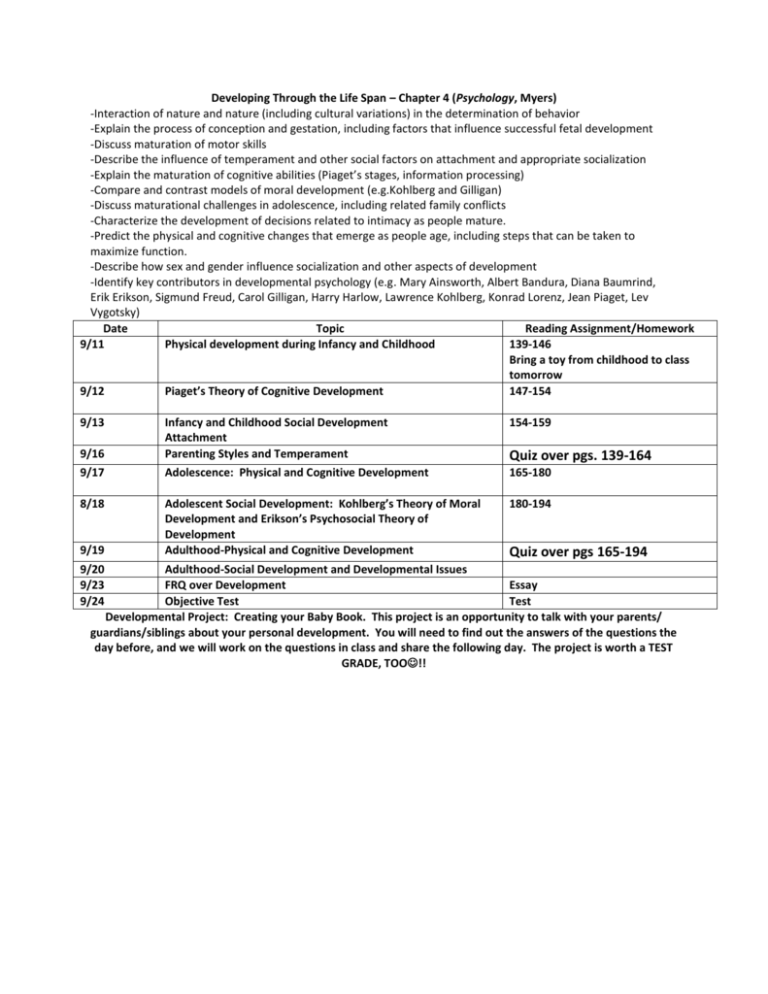
Developing Through the Life Span – Chapter 4 (Psychology, Myers) -Interaction of nature and nature (including cultural variations) in the determination of behavior -Explain the process of conception and gestation, including factors that influence successful fetal development -Discuss maturation of motor skills -Describe the influence of temperament and other social factors on attachment and appropriate socialization -Explain the maturation of cognitive abilities (Piaget’s stages, information processing) -Compare and contrast models of moral development (e.g.Kohlberg and Gilligan) -Discuss maturational challenges in adolescence, including related family conflicts -Characterize the development of decisions related to intimacy as people mature. -Predict the physical and cognitive changes that emerge as people age, including steps that can be taken to maximize function. -Describe how sex and gender influence socialization and other aspects of development -Identify key contributors in developmental psychology (e.g. Mary Ainsworth, Albert Bandura, Diana Baumrind, Erik Erikson, Sigmund Freud, Carol Gilligan, Harry Harlow, Lawrence Kohlberg, Konrad Lorenz, Jean Piaget, Lev Vygotsky) Date Topic Reading Assignment/Homework 9/11 Physical development during Infancy and Childhood 139-146 Bring a toy from childhood to class tomorrow 9/12 Piaget’s Theory of Cognitive Development 147-154 9/13 154-159 9/16 Infancy and Childhood Social Development Attachment Parenting Styles and Temperament 9/17 Adolescence: Physical and Cognitive Development 165-180 8/18 Adolescent Social Development: Kohlberg’s Theory of Moral Development and Erikson’s Psychosocial Theory of Development Adulthood-Physical and Cognitive Development 180-194 9/19 9/20 9/23 9/24 Quiz over pgs. 139-164 Quiz over pgs 165-194 Adulthood-Social Development and Developmental Issues FRQ over Development Essay Objective Test Test Developmental Project: Creating your Baby Book. This project is an opportunity to talk with your parents/ guardians/siblings about your personal development. You will need to find out the answers of the questions the day before, and we will work on the questions in class and share the following day. The project is worth a TEST GRADE, TOO!! Define and identify the following terms and individuals. Terms will be due the day of the test objective test. 1. accommodation 2. adolescence 3. Alzheimer’s disease 4. assimilation 5. attachment 6. autism 7. basic trust 8. cognition 9. concrete operational stage 10. conservation 11. critical period 12. cross-sectional study 13. crystallized intelligence 14. developmental psychology 15. egocentrism 16. embryo 17. fetal alcohol syndrome 18. fetus 19. fluid intelligence 20. formal operational stage 21. habituation 22. identity 23. imprinting 24. intimacy 25. longitudinal study 26. maturation 27. menarche 28. menopause 29. object permanence 30. preoperational stage 31. primary sex characteristics 32. puberty 33. rooting reflex 34. schema 35. secondary sex characteristics 36. self-concept 37. sensorimotor stage 38. social clock 39. stranger anxiety 40. teratogens 41. theory of mind 42. zygote My Baby Book: A Record of Development Directions: You will design and create a personal baby book that discusses many aspect of your personal development since day one! Follow the guidelines below (and exactly in this order) to create your baby book. You may use your mom, dad, or other family references to connect your past to the developmental concepts we will discuss in this unit. This is a creative assignment. Your baby book should not only contain personal and factual information, but it should also be decorative and unique to your personality. You should have a total of five pictures in your baby book (copies are fine). You should be creative, colorful, and insightful, and careful of detail. Section 1: Your General Fact Sheet-Include graphics and detail wherever possible. A. In one paragraph, describe your mom’s pregnancy with you. B. Why were you given your name? C. What were the other names your parents were considering? Include both male and female names. Section 2: Your physical development 1. How long was your mom in labor? 2. What was your birth weight and length? 3. Photo: Include a baby picture taken of you at or right around birth. 4. How many months old were you when you learned to sit up? 5. How old were you when your first tooth came in? 6. How old were your when you took your first step? 7. When were you officially potty trained? 8. When did you lose your first tooth? 9. Compare your development for items #4,5, and 6 with the averages. (look in your book) 10. Create a timeline of average brain development 11. Discuss myelination and at which point you might personally be affected. 12. What is your current vision? (Do you have 20/20 vision? Do you wear glasses, contacts?) 13. At what age did you get glasses and/or contacts? 14. Define “puberty” in your own words. Based on the characteristics of puberty, explain whether adolescence comes at a fixed age for all. 15. Photo: Include a picture of yourself around the age of puberty 16. Make up and write a story about two friends (same gender as you), on who is an early bloomer and one who is a late bloomer. How are their experiences different, better, or worse? What comes out of both of their experiences? 17. Draw up a “Compare/Contrast” list between males and females for all the physical changes in both genders’ adult years. Define all terms, and provide results or consequences wherever appropriate. Section 3: Your Language Development-Include Graphics and detail where possible 18. What was your first word? 19. When did you first say this word? 20. Why was this word your first? 21. Were there any funny sounds, words, and/or phrases you used to use? 22. If so, what were these sounds, words, and/or phrases supposed to mean? 23. Define telegraphic speech, overgeneralization, and overextension (in your own words). 24. Did you use these forms of speech in any way? How? Provide examples. 25. Did you experience any language barriers during language formation? (i.e. stuttering, lisps, etc.) 26. Photo: Include a picture of yourself in the late-childhood years. Section 4: Your Social-Emotional Development 27. Who were you most attached to and why? 28. Define “imprinting” and explain whether this theory supports your attachment. 29. Were there any object that you formed attachments with? 30. Were these attachments formed similar to Harlow’s “contact comfort”? Why or why not? Make sure to define “contact comfort” in your own words. 31. Explain the overall effects of having no attachments in one’s childhood. Include a personal example if your feel as though you fall into this category. 32. Photo: Include a picture from your early childhood years. 33. Summarize what adults experience, regarding later intimacy and attachment, as a result of the various infancy attachment levels. Section 5: Your Cognitive Development 34. Admit to and explain, with your greatest humility, a specific time when you performed or experienced adolescent egocentrism, personal fable, and imaginary audience. Section 6: Moral Development 35. Write a paragraph explaining “where you are” regarding Kohlberg’s theory of moral development. 36. Photo: Include your most recent (late adolescent) picture. Section 7: Your Personality Development 37. Look at the “temperament theory” and Thomas and Chess’ temperament categories. Explain what type of child you were, based on this information. Give detail or examples. 38. Write a ½ or 1 page personal journal about why stages #5 and #6 of Erikson’s eight stages of personality development may be the highest hurdles to jump in life. Think about your middle school and high school years and what’s to come in your post-high school years. Include physical, emotional, cognitive aspects, and explain how these all fit into Erikson’s stages #5 and #6. This may be hand-written in a scrapbook form, or you may type the information. In addition, you will have time to work on this throughout the development unit. ENTIRE PROJECT IS DUE Monday, September 30, 2013

